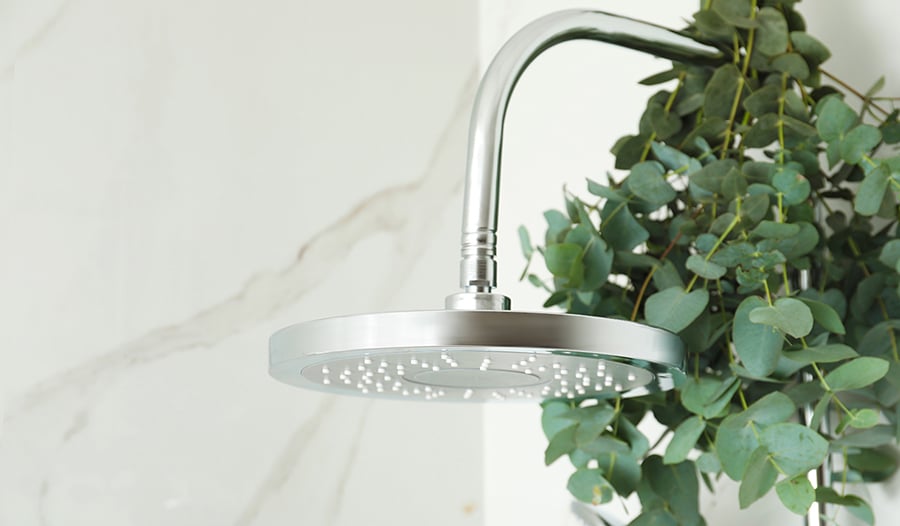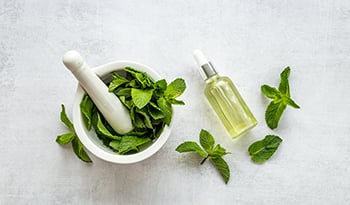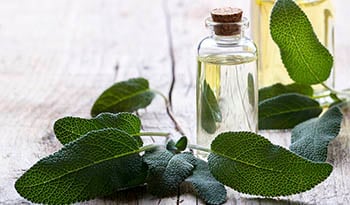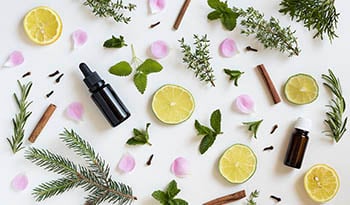유칼립투스 오일의 3가지 용도
면책사항:이 블로그는 진단을 제공하기 위한 것이 아닙니다.
- 이 글에서 다룰 내용:
- 유칼립투스 오일의 용도
- 호흡기 질환 증상 완화제
- 항균제
- 벌레퇴치제
- 안전성
- 결론

유칼립투스 오일의 용도
유칼립투스 에센셜 오일은 고대부터 폐 질환을 치유하고 병균을 억제하는 데 사용되어 왔습니다. 유칼립투스 오일은 수증기 증류법으로 유칼립투스 잎에서 추출됩니다. 이 오일은 잎과 마찬가지로 강하고 상쾌하며 아주 독특한 향을 냅니다. 에센셜 오일은 다양한 종의 유칼립투스에서 얻을 수 있으며 각 종류의 오일은 다소 다른 효능을 나타냅니다.
대부분의 유칼립투스 오일은 주성분이 유칼립톨[Eucalyptol, 1,8-시네올(1,8-cineole)]로 그 함량은 45-77%에 달하며 그 이상인 경우도 있습니다. 유칼립투스 에센셜 오일은 흉부 울혈 및 코막힘 완화를 위해 몸에 바르는 제제에 첨가되는 경우가 많습니다. 많은 민간요법과 마찬가지로 유칼립투스 오일의 본래 용도는 최근 연구에서 과학적 근거를 입증하고 있습니다.
호흡기 질환 증상 완화제
대부분의 사람은 유칼립투스 오일이라고 하면 코막힘과 흉부 울혈 증상을 완화하기 위해 흡입하는 오일로 생각할 것입니다. 이 오일의 주성분인 유칼립톨은 점액을 용해하는 특성이 있습니다. 쉽게 말해 유칼립톨은 점액을 줄이는 데 도움이 됩니다. 연구에 따르면 유칼립톨은 점액 생성에 관여하는 두 유전자의 발현을 현저히 감소시킵니다.
유칼립톨은 점액을 녹일 뿐 아니라 기도를 따라 위치한 평활근을 이완시킬 수도 있습니다. 이를 통해 폐를 더 확장하여 울혈을 완화함으로써 원활한 호흡을 돕습니다. 유칼립투스 오일은 이러한 효능과 함께 강력한 항염 활성도 나타내므로 호흡기 질환을 개선하는 데 매우 효과적입니다. 호흡기 질환을 완화하는 유칼립투스 오일의 효능에 관한 연구에서는 대부분의 경우 경구용 캡슐 형태의 정제된 유칼립톨이 사용되었습니다.
항균제
유칼립투스는 항균 효과를 나타내는 것으로 잘 알려져 있지만 유칼립투스 종에 따라 효능이 크게 다릅니다. 일부 종의 오일은 곰팡이, 박테리아, 기생충을 죽이는 데 효과적이며 항바이러스 효능을 나타낼 수도 있습니다.
곰팡이
연구에 따르면 유칼립투스 에센셜 오일은 입안에 서식하는 칸디다균에 대해 표준 항곰팡이제와 유사한 효과를 보인 것으로 나타났습니다. 이러한 연구 결과에 근거하여 연구진은 희석한 유칼립투스 오일이 구강 위생을 유지하는 데 도움이 되는 것으로 결론지었습니다. 오래전부터 유칼립투스는 다양한 천연 구강세정제의 성분으로 첨가되고 있습니다.
박테리아
항생제 남용으로 인해 표준 치료에 사용되는 항생제에 대한 박테리아의 내성이 강해지고 있습니다. 황색포도상구균 및 결핵균을 비롯한 여러 박테리아가 항생제 내성이 있는 것으로 잘 알려져 있습니다. 최근 연구에 따르면 유칼립투스 에센셜 오일은 대부분의 메티실린 내성 황색포도상구균(Methicillin-resistant Staphylococcus aureus, MRSA)을 억제하는 데 효과적일 수 있는 것으로 나타났습니다. 다른 연구에서도 유사한 결과가 나왔습니다.
전 세계 사람들 중 약 4분의 1이 결핵을 일으키는 박테리아에 감염되어 있으며 이들 중 일부는 치명적인 감염성 폐 질환인 결핵에 걸리게 됩니다. 결핵은 마이코박테리움 투버큘로시스(Mycobacterium tuberculosis)를 포함하는 마이코박테리아(Mycobacteria)에 의한 감염으로 인해 발병합니다. 연구에 따르면 1%로 희석된 유칼립투스 에센셜 오일은 다제내성 마이코박테리아의 성장을 완전히 억제할 수 있기 때문에 잠재적 결핵 치료제로 유망한 것으로 나타났습니다.
기생충
포낭충은 동물에 기생하면서 인간을 감염시킬 수 있는 촌충의 일종입니다. 연구에 따르면 양의 촌충 유충은 1% 유칼립투스 용액에 노출된 지 1분 이내에 모두 죽은 것으로 나타났습니다. 이러한 효과는 표준 약물인 포비돈 요오드(Povidone-iodine)나 질산은과 대등한 수준입니다.
머릿니는 흔히 어린이에게 감염되는 또 다른 유형의 기생충입니다. 일반적으로 머릿니 감염을 치료할 때는 신경독성 살충제인 퍼메트린(Permethrin)을 사용합니다. 하지만 연구에서 유칼립투스 오일도 머릿니를 제거할 수 있는 것으로 밝혀졌습니다. 연구에 따르면 10% 유칼립투스 오일에 서캐를 5분간 노출했을 때 효과적으로 죽일 수 있었던 반면 퍼메트린에 10분간 노출했을 때는 서캐의 95%가 부화했습니다. 생강 에센셜 오일도 유칼립투스와 유사한 결과를 나타냈습니다. 유칼립투스와 생강을 병용했을 때 효과가 더 높아졌습니다.
벌레퇴치제
연구에 따르면 레몬 유칼립투스를 비롯하여 유칼립투스속의 일부 종은 천연 벌레퇴치제로서의 가능성을 보입니다. 레몬 유칼립투스 에센셜 오일은 레몬 같은 특유의 향을 냅니다. 레몬 유칼립투스 오일은 미국 환경보호청(Environmental Protection Agency)이 천연 벌레퇴치제 목록에 포함할 정도로 벌레를 쫓아내는 능력이 뛰어납니다. 일반적인 유칼립투스와는 달리 레몬 유칼립투스는 시트로넬랄(Citronellal)이라는 물질이 풍부합니다.
곤충을 퇴치하는 데 효과적인 천연 화학물질의 예로는 다양한 에센셜 오일의 일반적인 성분인 리모넨(Limonene), 유칼립톨, 제라니올(Geraniol), 유제놀(Eugenol), 시트로넬랄 등을 들 수 있습니다. 리모넨은 오렌지, 레몬, 라임에 들어 있습니다. 유칼립톨은 유칼립투스에서 얻을 수 있습니다. 제라니올은 장미 오일, 팔마로사(Palmarosa), 시트로넬라 오일(Citronella oil)에 함유되어 있습니다. 유제놀은 주로 클로브(Clove) 에센셜 오일에 존재합니다. 시트로넬랄은 레몬 유칼립투스와 시트로넬라 에센셜 오일의 성분입니다. 이러한 에센셜 오일을 조합해서 사용하면 자연적으로 벌레를 퇴치하는 데 효과적일 것입니다.
단, 중남미 지역에만 해당되는 이야기지만 유칼립톨은 침을 쏠 수 있는 여러 종의 난초벌(Orchid bee)을 유인할 수 있습니다. 하지만 이 벌은 꿀벌보다 덜 위험한 것으로 여겨지며 다른 지역에는 서식하지 않습니다.
안전성
유칼립투스 에센셜 오일의 효과를 조사한 연구에서는 경구 섭취하는 형태의 정제된 유칼립톨을 사용한 경우가 많습니다. 에센셜 오일에는 강력한 효능을 나타내는 천연 화학물질이 함유되어 있으며 제품에 따라 불순물이 혼합되는 경우도 허다합니다. 최근 추정치에 의하면 시중에 판매되는 에센셜 오일 중에서 어떤 방식으로든 불순물이 섞인 제품은 최대 80%에 달할 수 있습니다.
에센셜 오일을 섭취하려 한다면 안전하게 올바른 용량을 사용할 수 있도록 전문 의료인의 권고에 따라 시도해야 합니다. 에센셜 오일을 약용으로 사용하려면 독립적인 실험실 분석을 통해 에센셜 오일의 순수성을 확인하는 것도 중요합니다.
결론
연구에 따르면 유칼립투스 에센셜 오일과 그 성분은 호흡기 질환 치료제로서의 가능성이 있습니다. 또한 유칼립투스는 항바이러스 효능과 더불어 특정 박테리아, 곰팡이, 기생충을 비롯하여 다양한 유기체에 항균 효과를 나타내는 것으로 보입니다. 레몬 유칼립투스 오일 등과 같은 에센셜 오일을 첨가한 벌레퇴치제도 많이 사용될 전망입니다.
참고문헌:
- Aldoghaim FS, Flematti GR, Hammer KA. Antimicrobial Activity of Several Cineole-Rich Western Australian Eucalyptus Essential Oils. Microorganisms. 2018;6(4):122. Published 2018 Dec 3. doi:10.3390/microorganisms6040122
- Tyagi AK, Malik A. Antimicrobial Potential and Chemical Composition of Eucalyptus globulus Oil in Liquid and Vapour Phase Against Food Spoilage Organisms. Food Chem. 2011;126(1):228-235.
- Sudhoff H, Klenke C, Greiner JF, et al. 1,8-Cineol Reduces Mucus-Production in a Novel Human Ex Vivo Model of Late Rhinosinusitis. PLoS One. 2015;10(7):e0133040. Published 2015 Jul 24. doi:10.1371/journal.pone.0133040
- Nascimento NR, Refosco RM, Vasconcelos EC, et al. 1,8-Cineole induces relaxation in rat and guinea-pig airway smooth muscle. J Pharm Pharmacol. 2009;61(3):361-366. doi:10.1211/jpp/61.03.0011
- Juergens UR. Anti-inflammatory properties of the monoterpene 1.8-cineole: current evidence for co-medication in inflammatory airway diseases. Drug Res (Stuttg). 2014;64(12):638-646. doi:10.1055/s-0034-1372609
- Fischer J, Dethlefsen U. Efficacy of cineole in patients suffering from acute bronchitis: a placebo-controlled double-blind trial. Cough. 2013;9(1):25. Published 2013 Nov 21. doi:10.1186/1745-9974-9-25
- Tesche S, Metternich F, Sonnemann U, Engelke JC, Dethlefsen U. The value of herbal medicines in the treatment of acute non-purulent rhinosinusitis. Results of a double-blind, randomised, controlled trial. Eur Arch Otorhinolaryngol. 2008;265(11):1355-1359. doi:10.1007/s00405-008-0683-z
- Worth H, Schacher C, Dethlefsen U. Concomitant therapy with Cineole (Eucalyptole) reduces exacerbations in COPD: a placebo-controlled double-blind trial. Respir Res. 2009;10(1):69. Published 2009 Jul 22. doi:10.1186/1465-9921-10-69
- Koshak A, Wei L, Koshak E, et al. Nigella sativa Supplementation Improves Asthma Control and Biomarkers: A Randomized, Double-Blind, Placebo-Controlled Trial. Phytother Res. 2017;31(3):403-409. doi:10.1002/ptr.5761
- Gupta I, Gupta V, Parihar A, et al. Effects of Boswellia serrata gum resin in patients with bronchial asthma: results of a double-blind, placebo-controlled, 6-week clinical study. Eur J Med Res. 1998;3(11):511-514.
- Juergens UR, Dethlefsen U, Steinkamp G, Gillissen A, Repges R, Vetter H. Anti-inflammatory activity of 1.8-cineol (eucalyptol) in bronchial asthma: a double-blind placebo-controlled trial. Respir Med. 2003;97(3):250-256. doi:10.1053/rmed.2003.1432
- Worth H, Dethlefsen U. Patients with asthma benefit from concomitant therapy with cineole: a placebo-controlled, double-blind trial. J Asthma. 2012;49(8):849-853. doi:10.3109/02770903.2012.717657
- Noumi E, Snoussi M, Hajlaoui H, Trabelsi N, Ksouri R, Valentin E, Bakhrouf A.Chemical composition, antioxidant and antifungal potential of Melaleuca alternifolia (tea tree) and Eucalyptus globulus essential oils against oral Candida species. J Med Plant Res. 2011;5(17):4147-4156.
- Elaissi A, Rouis Z, Salem NA, et al. Chemical composition of 8 eucalyptus species' essential oils and the evaluation of their antibacterial, antifungal and antiviral activities. BMC Complement Altern Med. 2019; 19: 59. Published 2012 Jun 28. doi:10.1186/1472-6882-12-81
- Iseppi R, Mariani M, Condò C, Sabia C, Messi P. Essential Oils: A Natural Weapon against Antibiotic-Resistant Bacteria Responsible for Nosocomial Infections. Antibiotics (Basel). 2021;10(4):417. Published 2021 Apr 10. doi:10.3390/antibiotics10040417
- Tohidpour A, Sattari M, Omidbaigi R, Yadegar A, Nazemi J. Antibacterial effect of essential oils from two medicinal plants against Methicillin-resistant Staphylococcus aureus (MRSA). Phytomedicine. 2010;17(2):142-145. doi:10.1016/j.phymed.2009.05.007
- Merghni A, Noumi E, Hadded O, et al. Assessment of the antibiofilm and antiquorum sensing activities of Eucalyptus globulus essential oil and its main component 1,8-cineole against methicillin-resistant Staphylococcus aureus strains. Microb Pathog. 2018;118:74-80. doi:10.1016/j.micpath.2018.03.006
- El Omari K, Hamze M, Alwan S, Osman M, Jama C, Chihib NE. In-vitro evaluation of the antibacterial activity of the essential oils of Micromeria barbata, Eucalyptus globulus and Juniperus excelsa against strains of Mycobacterium tuberculosis (including MDR), Mycobacterium kansasii and Mycobacterium gordonae. J Infect Public Health. 2019;12(5):615-618. doi:10.1016/j.jiph.2019.01.058
- Schnitzler P, Schön K, Reichling J. Antiviral activity of Australian tea tree oil and eucalyptus oil against herpes simplex virus in cell culture. Pharmazie. 2001;56(4):343-347.
- Panikar S, Shoba G, Arun M, et al. Essential oils as an effective alternative for the treatment of COVID-19: Molecular interaction analysis of protease (Mpro) with pharmacokinetics and toxicological properties. J Infect Public Health. 2021;14(5):601-610. doi:10.1016/j.jiph.2020.12.037
- Moazeni M, Hosseini SV, Al-Qanbar MH, Alavi AM, Khazraei H. In vitro evaluation of the protoscolicidal effect of Eucalyptus globulus essential oil on protoscolices of hydatid cyst compared with hypertonic saline, povidone iodine and silver nitrate. J Visc Surg. 2019;156(4):291-295. doi:10.1016/j.jviscsurg.2019.01.002
- Soonwera M, Wongnet O, Sittichok S. Ovicidal effect of essential oils from Zingiberaceae plants and Eucalytus globulus on eggs of head lice, Pediculus humanus capitis De Geer. Phytomedicine. 2018;47:93-104. doi:10.1016/j.phymed.2018.04.050
- CDC. Avoid Bug Bites. Centers for Disease Control and Prevention. Update May 6, 2021. Accessed August 30, 2021. https://wwwnc.cdc.gov/travel/page/avoid-bug-bites#repellent
- da Silva MRM, Ricci-Júnior E. An approach to natural insect repellent formulations: from basic research to technological development. Acta Trop. 2020;212:105419. doi:10.1016/j.actatropica.2020.105419
- Satyal P, Setzer WN. Adulteration Analysis in Essential Oils. In: Malik S (eds) Essential Oil Research. Springer, Cham. 2009:261-273. https://doi.org/10.1007/978-3-030-16546-8_9
- Schiestl FP, Roubik DW. Odor compound detection in male euglossine bees. J Chem Ecol. 2003;29(1):253-257. doi:10.1023/a:1021932131526

 By 스콧 비징(Scott Buesing) 박사, 자연요법 의사
By 스콧 비징(Scott Buesing) 박사, 자연요법 의사


